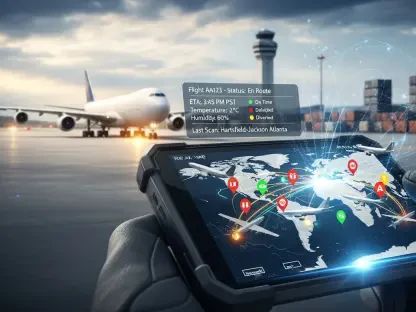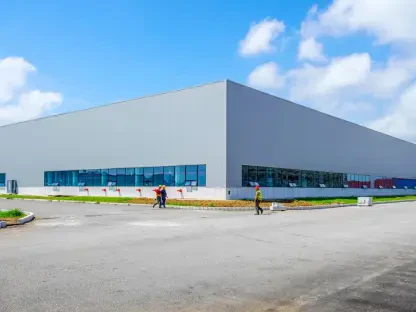In today’s rapidly evolving logistics industry, where technology and innovation are crucial, Rohit Laila stands out as an expert with decades of experience. His insights into the Leuze SmartID-Edge—a cutting-edge solution for enhancing transparency in warehouse and logistics operations—offer a fascinating glimpse into the future of supply chain management.
Can you explain the primary function of Leuze SmartID-Edge in warehouse and logistics operations?
Leuze SmartID-Edge brings a paradigm shift in managing identification systems and sensors for track-and-trace in production and the supply chain. Its core function revolves around ensuring secure communication between devices like 1D scanners and 2D cameras at the edge level. This integration allows for full utilization of the AutoID Companion Specification, which enhances transparency by providing real-time access to object and process data.
How does the secure communication process work between 1D scanners and 2D camera systems at the edge level?
The secure communication process is primarily facilitated through OPC UA, serving as a robust platform ensuring end-to-end encryption during data exchange. This interoperability allows for seamless connection and communication between different systems, guaranteeing that real-time data is both reliable and safeguarded against unauthorized access. It essentially creates a secure ecosystem for integrating various identification technologies.
What is the significance of the AutoID Companion Specification in the integration process?
The AutoID Companion Specification is crucial for ensuring standardized integration across different identification systems. It brings uniformity to the way data is exchanged, allowing systems to communicate effectively and process identification data with enhanced precision and efficiency. This specification helps mitigate the complexities of working with diverse automation systems and provides a common framework to operate freely.
How does Leuze SmartID-Edge ensure maximum transparency in object and process data?
Leuze SmartID-Edge ensures maximum transparency by utilizing virtual tags that exist in the edge system. Each object is mapped to these tags, which allows various process, status, and sensor information to be associated with it. This information is then accessible in real-time throughout the supply chain, ensuring that crucial data is always available for continuous process tracking without relying solely on higher-level IT systems.
Could you elaborate on the concept of a virtual tag in the SmartID-Edge system?
The virtual tag concept is an innovative approach to data handling where physical bar codes are mirrored in virtual space. It provides a digital representation of objects, allowing for additional data assignment, such as process and status information. This virtual tagging enriches the data set associated with each object and provides a comprehensive view that aids in improving traceability and operational efficiency.
How does real-time data exchange across network boundaries enhance process tracking?
Real-time data exchange across network boundaries establishes a seamless flow of information, ensuring that all relevant data is synchronized and readily available at field level. This integration means that any updates or changes in one part of the network are immediately reflected across the system, enhancing process tracking by providing stakeholders with instant access to the full scope of operations and enabling quicker decision-making.
What are the multiple requirements for efficient identification in modern automation systems?
Modern automation systems demand flexible identification mechanisms capable of handling diverse data volumes and code systems. This flexibility is essential for adapting to the various types of objects being processed and ensuring compatibility with different control systems, sensors, and actuators. Robust communication networks enable these systems to exchange information seamlessly, maintaining high-quality production standards.
How do sensors contribute to production process activation and monitoring?
Sensors are pivotal in activating production processes and monitoring ongoing procedures. They generate event-based signals that allow systems to react and respond to changes, ensuring operational accuracy. Additionally, sensors provide critical measurements used to verify the quality and correctness of production activities, playing a central role in maintaining efficiency and ensuring the final product meets established standards.
Why are classic 1D/2D codes considered limited in handling data?
Classic 1D/2D codes are limited by their predefined structure, which restricts the amount of data they can store. They generally require external IT systems like MES or ERP to access complete data records, which can create dependency and reduce flexibility in real-time operations. These limitations necessitate the integration of more versatile systems that can handle the dynamic demands of modern automation environments.
What are the advantages of RFID systems over standard bar codes in terms of data flexibility?
RFID systems offer significant advantages due to their programmable electronic memory, which allows data to be stored directly on the tags. This flexibility ensures that product or process-specific information is readily accessible, without relying on external databases. It provides a more adaptive approach to data handling, facilitating quicker access and enhanced process efficiency, especially in complex and evolving industrial environments.
Why might it not be practical or possible to use RFID technology in all cases?
Despite its advantages, RFID technology is not always practical due to economic and technical constraints. The cost of implementing RFID can be prohibitive in some cases, especially when considering the infrastructure required for readers and tags. Additionally, environments with high metallic interference or specific technical limitations can hinder RFID performance, making it unsuitable for certain applications.
What challenges arise from frequent media changes between bar codes and RFID?
Frequent media changes between bar codes and RFID pose significant challenges, primarily in consistency and data handling. These changes require adjustments in automation processes, increasing complexity and potentially leading to errors. Managing two different data formats can burden the system, demanding more resources and time and complicating workflow and synchronization efforts across production lines.
How does the SmartID-Edge concept leverage RFID mechanisms while using bar code technology?
SmartID-Edge brilliantly merges RFID mechanisms with classic bar code technology by assigning virtual RFID tags to physical bar codes. This concept allows bar code scanners and cameras to function with the enriched data handling capabilities typical of RFID systems, thereby optimizing data processes without necessitating a complete overhaul of existing bar code technology.
Can you describe the role of OPC UA in SmartID-Edge’s data exchange processes?
OPC UA plays a fundamental role by providing a standardized communication protocol that all systems within SmartID-Edge utilize for efficient data exchange. Its interoperability ensures that different devices and systems can communicate effectively, allowing for seamless data transfer at the edge level. OPC UA ensures uniformity, facilitating smoother integration and enhancing security by providing robust encryption.
What is a virtual RFID tag, and how does it interact with physical bar codes?
A virtual RFID tag is a digital concept linked with physical bar codes, functioning as a repository for expansive data associated with those codes. This virtual representation allows bar codes to operate as if they were RFID systems, benefiting from the richer data environment without needing physical tags. It enables enhanced data handling and real-time access to comprehensive information.
How does the edge server function in terms of data exchange at the field level?
The edge server acts as a central point for data exchange at the field level, collecting and distributing information from bar code devices. It manages and stores data within its system, allowing direct accessibility without involving the primary control systems such as PLCs. This setup ensures streamlined operations, making data exchange more efficient and reducing the load on higher-level IT systems.
Could you explain why the PLC has limited access to the edge server in this system?
The limitation of PLC access to the edge server is designed to optimize control and security within the system. By restricting access, the edge server can focus on the direct exchange of identification data with bar code systems, thus minimizing potential interference and maintaining operational integrity. This approach avoids burdening PLCs with extraneous processing and enhances the efficiency of network operations.
How does the SmartID-Edge platform promote data enrichment during object identification?
SmartID-Edge is engineered to enrich data during object identification by combining typical identifiers like object IDs with additional status and quality information from the identification system itself. This multidimensional data record is maintained in real-time, contributing to a more informed decision-making process and enabling better tracking and management of production processes with reduced need for external data queries.
In what ways does SmartID-Edge alleviate the need for queries to MES and ERP systems?
SmartID-Edge eliminates the necessity for frequent data queries to MES and ERP systems by centralizing and synchronizing essential data within the edge server itself. By having immediate access to identification and process data, operations can proceed without needing to verify information externally, significantly reducing network traffic and optimizing system resources, consequently enhancing overall operational efficiency.
How does synchronizing local sensor and AutoID networks via edge servers contribute to the creation of a digital twin?
Synchronizing local sensor and AutoID networks facilitates the creation of a digital twin by providing a real-time, dynamic representation of physical processes. It ensures that associated information stored in edge databases reflects the real-world operations, thus maintaining an accurate digital replica. This digital twin offers profound insights into the lifecycle of production and supply chains, enabling better forecasting and resource management.
How would you describe the security measures integrated into the SmartID-Edge solution?
Security measures in SmartID-Edge are multifaceted, leveraging OPC UA’s encryption protocols and automated certificate exchange mechanisms. These measures ensure all data transfers and system updates are protected from potential cyber threats, establishing a robust defense against unauthorized access. The security framework is designed to uphold the integrity and resilience of networked operations at every level.
What role does OPC UA play in ensuring secure communication within networked systems?
OPC UA establishes a secure communication platform, offering encryption and certificate management that protect data exchanges. Its specifications provide a standardized approach to handle device communication and management tasks securely. By integrating these capabilities into the SmartID-Edge framework, OPC UA assures that every interaction within the system is secure, reliable, and efficient for sustained network operations.
How does certificate exchange via a Global Discovery Server aid in managing applications and certificates?
Certificate exchange through a Global Discovery Server simplifies the management of applications and certificates by handling these components centrally. It automates interactions within the OPC UA network, ensuring certificates are consistently validated and updated. This centralized control streamlines security processes, maintaining continuity and significantly reducing the complexity inherent in managing a distributed network of devices.
What are the advantages of using edge servers and virtual data carriers for maximum transparency in track-and-trace applications?
Edge servers and virtual data carriers provide exceptional transparency by centralizing data exchange and storage, enabling real-time access to comprehensive object and process data. This setup supports efficient tracking and tracing across the supply chain, minimizing dependency on distant IT systems for critical data retrieval while ensuring that information is presented consistently and reliably throughout operations.
How does SmartID-Edge meet the requirements for cyber resilience?
SmartID-Edge meets cyber resilience demands by integrating robust security mechanisms and maintaining high encryption standards. It secures communications through OPC UA and automates certificate exchanges, ensuring integrity and preventing breaches. This resilience is vital for safeguarding operations against emerging threats and maintaining continuity and security in increasingly complex network environments.
Do you have any advice for our readers?
Incorporating advanced systems like SmartID-Edge can significantly boost productivity and operational transparency within logistics and supply chains. I encourage readers to embrace technology and innovation, ensuring they fully understand how these solutions integrate and the benefits they can offer. Stay informed, adapt to changes, and invest in technologies that propel your logistics operations toward future advancements.









